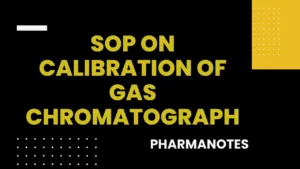SOP on Calibration of Gas Chromatograph(GC)

SOP on Calibration of Gas Chromatograph(GC)
1.0 PURPOSE
The purpose of the standard operating procedure is to define a method to calibrate the Gas Chromatography (GC).
2.0 SCOPE:
This standard operating procedure applies to the staff responsible for the operation and calibration of the Gas Chromatography (GC).
3.0 RESPONSIBILITY:
3.1 Section Incharge
3.2 Technical Manager
3.3 Q.A. Manager
4.0 PROCEDURE:
4.1 MATERIALS REQUIRED:
4.1.1 Instrument to be used
4.1.2 Hydrogen Cylinder
4.1.3 Air Cylinder
4.1.4 Calibrated Temperature Probe
4.1.5 Ethanol
4.1.6 Glassware
4.2 FLOW VERIFICATION:
Using the standard operating conditions start the carrier gas flow through at a set point.
Allow the gas to pass through the gas flow meter supplied with the instrument and record the gas flow rate.
Similarly allow the hydrogen gas and air gas to pass through at a set point flow rate of 30ml/minute and 300ml/minute respectively. The gases are allowed to pass through the gas flow meter and the flow rates recorded.
Correlate the observed gas flow rates with the set point flow rates and make adjustments, if necessary.
4.3 TEMPERATURE VERIFICATION:
Insert a calibrated temperature probe into the oven near the oven sensor. Allow all zones to stabilize and the to become ready. Record the actual temperature probe value for oven temperature.
4.4 Detector/Auto sampler Reproducibility
4.4.1 Repeatability (Precision)
Repeatability will look at the standard deviation of 6 injections of the same concentration of the 0.5% solution of ethanol. From the standard deviation the RSD is calculated. If the standard deviation is less than or equal to 2.0 % the test passes. The purpose of Repeatability is to verify that the Autosampler can repeatedly inject the same volume of sample numerous times. Inject 6 injections of 1mL each.
4.4.2 LINEARITY
Linearity will check that the Autosampler can accurately inject different concentration of ethanol. We do this by injecting multiple samples of different concentrations.
The injection volume is 1mL from 0.40%, 0.45%, 0.50%, 0.55% and 0.6 % w/v solution of ethanol. There should be linear be a linear relationship between sample concentration and area under the peak.
Frequently Asked Questions (FAQs)
Q1: Why is it necessary to calibrate a Gas Chromatograph (GC)?
A1: Calibrating a GC is essential to ensure the accuracy and reliability of analytical results. It helps maintain the instrument’s performance within acceptable limits and ensures compliance with regulatory requirements.
Q2: What materials and equipment are required for GC calibration?
A2: Materials include calibration standards, carrier gas, injection syringes, chromatograph columns, certified reference standards, calibration gas cylinders, and suitable software for data analysis.
Q3: How often should a GC be calibrated?
A3: Calibration frequency should follow the instrument’s maintenance schedule or regulatory guidelines. Typically, it is done at regular intervals to ensure consistent and accurate performance.
Q4: What is a system suitability test, and why is it performed during calibration?
A4: A system suitability test assesses the performance of the GC system. It checks parameters like resolution, peak shape, and retention times to ensure the system is suitable for analysis. This test is crucial for reliable and reproducible results.
Q5: How is a calibration curve generated during the GC calibration process?
A5: A calibration curve is generated by plotting the response of the GC detector against the known concentrations of calibration standards. The curve helps in quantifying the relationship between concentration and detector response.
Q6: What steps are involved in the GC calibration procedure?
A6: The procedure includes initial checks, column installation, system suitability testing, preparation and injection of calibration standards, data analysis, potential instrument adjustments, and a final system check.
Q7: Can adjustments be made to the GC instrument based on calibration results?
A7: Yes, adjustments may be necessary to optimize instrument parameters based on calibration results. Any adjustments made should be documented.
Q8: What records should be maintained during GC calibration?
A8: Records should include details of calibration standards, results, adjustments (if any), and outcomes of system suitability tests. These records provide a comprehensive overview of the calibration process.
Q9: Who is responsible for approving GC calibration records?
A9: The designated authority, often within the Quality Assurance department, is responsible for reviewing and approving GC calibration records before the instrument is released for routine use.
Q10: Why is training essential for personnel involved in GC calibration?
A10: Training ensures that personnel are familiar with the calibration procedure, understand the importance of each step, and can execute the process accurately, contributing to reliable analytical results.
Also, Visit:
B. Pharma Notes | B. Pharma Notes | Study material Bachelor of Pharmacy pdf